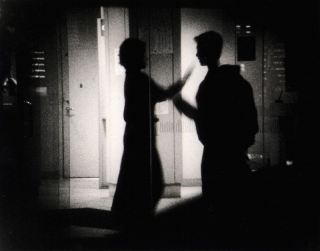Date: 30 October 2004 | Season: London Film Festival 2004 | Tags: London Film Festival
TRAVEL SONGS
Saturday 30 October 2004, at 4pm
London National Film Theatre NFT3
Robert Breer, What Goes Up, USA, 2003, 5 min
A volley of rapid visual associations from the mind of Robert Breer, animating collage, drawings and snapshots in a playful, but rigorous manner. What goes up must come down.
Jonas Mekas, Travel Songs 1967-1981, USA, 2003, 24 min
In short bursts and single frames, memories of European journeys rush by like landscapes through train windows. This ebullient album of previously unseen footage contains songs of Assisi, Avila, Moscow, Stockholm and Italy.
Frank Biesendorfer, Little B & MBT, USA-Germany, 2003, 30 min
An intimate journal featuring the film-maker’s family in their daily life, contrasted with audio recorded at one of Hermann Nitsch’s actions in his Austrian castle. Despite their diverse sources, the sound and image weave a tangled spell around each other.
Robert Fenz, Meditations on Revolution V: Foreign City, USA, 2003, 32 min
The Meditations series comes home for a journey through New York, viewed as a place of immigration and displacement. The urban environment, shot mostly at night in ecstatic black-and-white, becomes an almost exotic locale. Fenz’s incandescent cinematography reveals images of great beauty and compassion on the sidewalks and subway, as the film subtly shifts from anonymous street scenes into a sensitive portrait of jazz legend Marion Brown, who reminisces on his life and career as he convalesces in hospital.
PROGRAMME NOTES
TRAVEL SONGS
Saturday 30 October 2004, at 4pm
London National Film Theatre NFT3
WHAT GOES UP
Robert Breer, USA, 2003, 16mm, colour, sound, 5 min
In observance of gravity – the airplane, the priapic flesh, the deciduous leaf, the upturned nose, the kitten up a tree, the towering Empire – All Must Fall. As a man who fell to earth Breer branches off into playful tangents and bursts creating complex spaces cartwheeling through time’s latest seasons. Quick as a snapshot, hard as a slingshot, lighter than a ton of feathers. (Mark McElhatten, New York Film Festival Views from the Avant-Garde)
TRAVEL SONGS 1967-1981
Jonas Mekas, USA, 2003, 16mm, colour, sound, 24 min
Mekas’ sublime Travel Songs, each of which run for five minutes or less, communicate the colourful and deepened sense of their varied locales (Italy, Russia, New York, etc). Mekas’ camera is always in motion, restlessly flipping back and forth on seemingly impossible zigzag trajectories. Central to his work is a feeling of forward momentum, Mekas sees the human condition as a hurtling train of experience. The momentary, split-second pauses in his camera movements – often focusing on either the fruits of nature or specific aspects of human physiognomy – suggest myriad paths of understanding and enlightenment. Mekas desperately tries to drink it all in and, happily for him and for us, fails. Like an immortal flower in constant bloom, Mekas’ films are an ever-expanding document of life in perpetual motion, personal profundity at twenty-four frames per second. (Keith Uhlich)
LITTLE B & MBT
Frank Biesendorfer, USA-Germany, 2003, 16mm, colour, sound, 30 min
The soundtrack is made from my recordings of voices, discussions and sounds surrounding a recent Hermann Nitsch action in Austria. The images, consisting primarily of special and intimate moments of his wife and children, intertwine with the audio in strange and ambiguous ways. The film battles itself in order to cancel itself out, but the conflict remains circular and supersedes both the audio and visual, in a place beyond the material and physical. (Frank Biesendorfer)
MEDITATIONS ON REVOLUTION V: FOREIGN CITY
Robert Fenz, USA, 2003, 16mm, colour, sound, 32 min
The final film in Fenz’s series “Meditations on Revolution.” The film is dedicated to the director’s father who immigrated to the United States in 1953 and passed away in 1999. Foreign City studies New York as a place of immigration and displacement. It is a meditation on revolution of the urban space. Its abstract black and white images and actual sounds come in and out of synch, creating a magical foreign landscape. The reconstruction of N.Y. through an imaginary city plan, built on sensation. The film has a timeless, anonymous quality until it is given the voice of artist and jazz musician Marion Brown. (Robert Fenz)
Back to top
